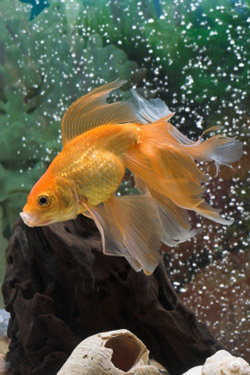Fish: Control of Algae
Excess algal growth is seen by green water and/or a green blanket of hairs on the gravel, glass sides or plant leaves. In new aquaria, or where the lighting is low, a brown form will grow. Rarely, a blue or red form is seen. To eliminate algae, three conditions of the aquarium must be examined and corrected if necessary.
Lighting
Excess lighting will encourage algae, especially if sunlight strikes the tank. Always shade the aquarium from natural light and use artifical lighting, which can be controlled. If real plants are used, these require a certain intensity of light per area of leaf to photosynthesise, hence the same light levels are required whether you have one plant or one hundred. If the real plants are few in number, the surplus light grows algae, therefore plant densely or not at all.
An aquarium with plastic plants can have lower levels of lighting, just for viewing, and this will help inhibit algal growth.
Balance
The ideal aquarium has a biological balance, seen by ice-like clarity to the water with lively, colourful fish. The bacteria in the tank will balance the excreta from the fish, providing the water is regularly diluted via partial water changes (25 percent every week or two). If the aquarium is neglected, the dissolved solids from excess food, faeces, plant debris and bacterially produced nitrates will fertilise the algae, encouraging rapid growth.

Feeding
Surplus food will encourage algal growth, so always feed a few flakes to the waiting fish and stop as soon as a few are left over. Remove the surplus, too. Beware of frozen or fresh foods that cloud the water with dissolved or finely dispersed nutrients.
Algae Treatment
It is no use pouring Algae Cures into a tank full of algae and excess biological matter. The imbalanced tank will just absorb the active ingredients and the algae merely falter and then start regrowing. Scrape off all the algae possible and siphon it out. Ornaments, rocks and plastic plants can be bleached clean (rinse thoroughly). Do a 25 percent water change, "hovering" the gravel with the siphon tube. Then add an algae treatment to prevent regrowth.
If you prefer to have algae in the aquarium, keep the front glass clear with a cleaning magnet or (soapless) plastic scourer. Use lots of light that favor the green over the brown or blue varieties. Algal volume can be controlled with algae-eating fish such as Sucking Loach, Bristle-nosed Catfish or a Plecostomus. Snails will not help—in fact they will breed until their numbers become a problem.
[ Search Articles ] [ Article Index ]
